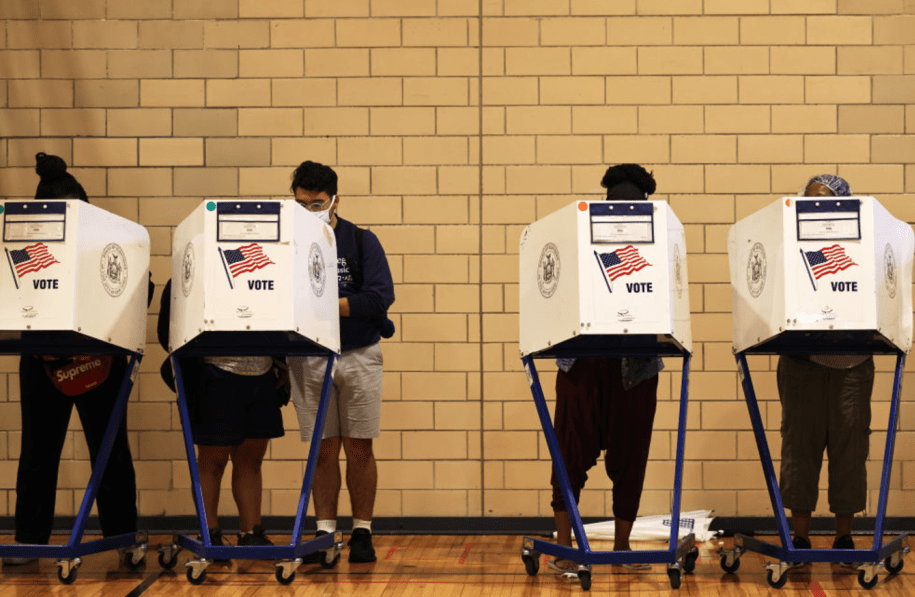| Sravya Tadepalli ∙ Daily Kos |
Ranked-choice voting has grown in popularity across the country in recent years, with 42 jurisdictions presently implementing some version of it. In most ranked-choice voting systems, voters rank candidates for elected office in their order of preference. If one candidate wins a majority of first-choice votes in the first round, that candidate is elected. If no candidate gains a majority, the candidate with the fewest votes is eliminated and their votes are reallocated to the voters’ second choice candidates. This process goes on until one candidate wins a majority.
”50 jurisdictions across the country are expected to use ranked-choice voting in their next election.
One of the most popular arguments in support of ranked-choice voting is that it gives more opportunities for independent and third-party candidates to win elections. In both the 2000 and 2016 presidential elections, a substantial number of left-leaning voters cast their ballots for the Green Party, creating a “spoiler effect” that reduced the total number of votes for the Democratic candidate and in some states, handed victory to the Republican. In a ranked-choice voting system, people could vote for a third-party candidate without fear of vote-splitting. If the third-party candidate is unpopular, they are eliminated and a third-party voter’s second choice is considered in the automatic runoff. Ranked-choice voting allows voters to vote for third party and independent candidates without fear of inadvertently contributing to the election of an ideological opponent.
Recent research found that California cities that adopted ranked-choice voting had more candidates of color running for office and more women candidates of color winning. A study by FairVote, an organization that advocates for ranked-choice voting across the country, found that voters of color tended to rank more candidates than white voters, and candidates of color benefitted from the system at a higher rate than white candidates.
In Ann Arbor, where residents overwhelmingly voted in favor of adopting ranked-choice voting on Tuesday, community members expressed excitement about the possibility of having more inclusive and less partisan elections.
“Most [supporter] comments have been about breaking the two-party system and having more selection in their options,” said Pat Zabawa, communications director for the Rank MI campaign. “Some were unsure, but on the other hand they were pretty excited to hear about it being implemented in the primaries.”
Ann Arbor actually briefly adopted a ranked-choice voting system in the 1970s, after a Republican candidate won a three-way race in 1973 without a majority. When the system was adopted in 1975, Ann Arbor elected its first Black mayor. The city dropped ranked-choice voting soon after that election, but proponents have used this example to show its potential for diversifying elected officials. According to FairVote, approximately 41% of winners in 1,422 ranked-choice voting elections have been people of color.
“The win, especially the high margin, means that we have renewed energy to advocate for ranked-choice voting in other cities throughout the state,” said Zabawa after hearing the election results. “I personally am very excited to learn that so many people in the Ann Arbor community support improving its elections with ranked-choice voting and aren’t afraid of improving their democracy in this way.”
Experimenting with ranked-choice voting
The New York City mayoral election primary in June was the city’s first use of the ranked-choice voting system, generating one of the largest and most prominent tests in the country. With a field of 13 candidates to choose from, voters had the opportunity to rank up to five candidates on their ballots. Eric Adams, who garnered around 30% of first-choice votes in the Democratic Party mayoral primary, went on to secure the nomination, eventually winning the mayoral election. New Yorkers turned out in record numbers for the mayor’s race, and 95% of voters said the ranked-choice voting system was easy to understand.
While cities like San Francisco and Minneapolis adopted the system for municipal elections in the 2000s, Maine became the first state to adopt ranked-choice voting in 2016, after people cast their votes in favor of the new system. The initiative process was led by grassroots organizers who wanted to preserve Maine’s tradition of independent and third-party candidates, while also ensuring that candidates had the support of the majority. At the time Maine adopted ranked-choice voting, nine of the state’s last 11 governors had won with only a plurality.
Several opponents launched legal challenges to the system in the following years, arguing that it was unconstitutional, but lawsuits were repeatedly rejected. Maine has now used ranked-choice voting for multiple state and federal election cycles.
More than 50 jurisdictions across the country are expected to use ranked-choice voting in their next election.
Sravya Tadepalli is a freelance writer based in Oregon. Her writing has been featured in Arlington Magazine, Teaching Tolerance, the Portland Tribune, Oregon Humanities, and the textbook America Now. Sravya is also a 2018 Harry S. Truman Scholar.





